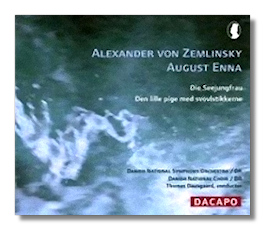
The Internet's Premier Classical Music Source
Related Links
- Zemlinsky Reviews
- Latest Reviews
- More Reviews
-
By Composer
-
Collections
DVD & Blu-ray
Books
Concert Reviews
Articles/Interviews
Software
Audio
Search Amazon
Recommended Links
Site News
 CD Review
CD Review
Music on Themes by Hans Christian Andersen

The non-Disney Versions
- August Enna: The Little Match-Girl
- Alexander von Zemlinsky: Die Seejungfrau
Inger Dam-Jensen, soprano
Ylva Kihlberg, soprano
Danish National Radio Children's Choir
Danish National Radio Choir
Danish National Radio Symphony Orchestra/Thomas Dausgaard
Marco Polo da capo 8.226048 75:18
Summary for the Busy Executive: Fading Romanticism.
Both composers created these works around the turn of the century, based on well-known stories by Hans Christian Andersen. August Enna, a Dane of Sicilian-Jewish family (his guilt level must have soared into the stratosphere), made his living as a commercial musician before turning to composition. He never studied formally with anyone. He made his name as an opera composer and, to judge by the work here, one strongly influenced by Wagner. He lived a long life, dying in 1939, his music increasingly set aside. Zemlinsky, of course, is the near-contemporary of Mahler. In his day, pre-World War I Vienna, his star burned brightly. His reputation also went into eclipse as his idiom passed out of fashion. Every so often, performers, particularly conductors, try to revive him.
The depressing thing about this CD is how good it is. Neither of these works suffers from incompetence or triviality or lack of poetic impulse. On the other hand, you can see why the contemporary musicians whose works have survived – Debussy, Nielsen, Sibelius, Schoenberg, Mahler, Elgar, and Strauss among others – felt that they had to do something else. Both Enna and Zemlinsky manipulate the compositional strategies of late Romanticism as well as anybody, but their works remain fundamentally weak. The maneuvers come across as predictable and tired.
Enna, for example, gets a rich, typically Wagnerian sound from his orchestra, but it's always the same sound. In a work with full orchestra, choir, and children's choir to boot, he gets hardly any color variety. Also, for an opera composer, the work is curiously undramatic. "The Little Match Girl" (Den lille pige med svovlstikkerne) may not have been the best choice for an opera, even a short opera, and in its home country Enna's work survives mainly in concert. Andersen, like Dickens, mixes grim, sharply-observed reality, with sentimentality. Enna misses the first and settles for the second. The emotions come across as conventionally as an eighteenth-century pastorale. The Wagnerianisms don't translate into psychological perception.
Zemlinsky's tone poem, on the other hand, uses the orchestra with Mahlerian subtlety of color shift. The colors themselves are gorgeous and at times blazingly original. It lacks, however, Mahler's incisive line and sense of drama. Die Seejungfrau ("The Little Mermaid") is one of those pieces that allow you to leave the room for five minutes at a time (pick your own five minutes) and return to pretty much where you left off, having missed nothing of consequence.
The performances, on the other hand, are wonderful, with Dausgaard's orchestra standing out. Their sound is rich, Dausgaard's attention to Zemlinsky's argument (such as it is) and pastel fadeaways superb. I've heard more celebrated orchestras and conductors in the Zemlinsky, and the home team beats them all, in a live recording yet. The sound is studio-quality. That is, you really can't tell it's a live performance until you hear the chorus tromping on stage or the applause at the end of each work.
Copyright © 2008, Steve Schwartz



















